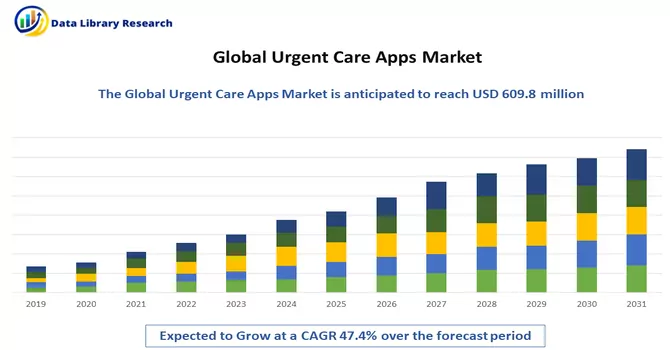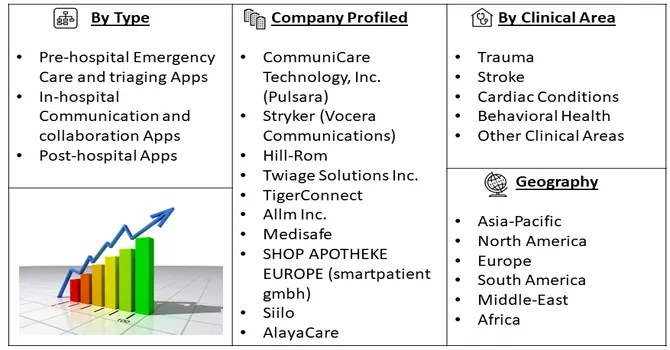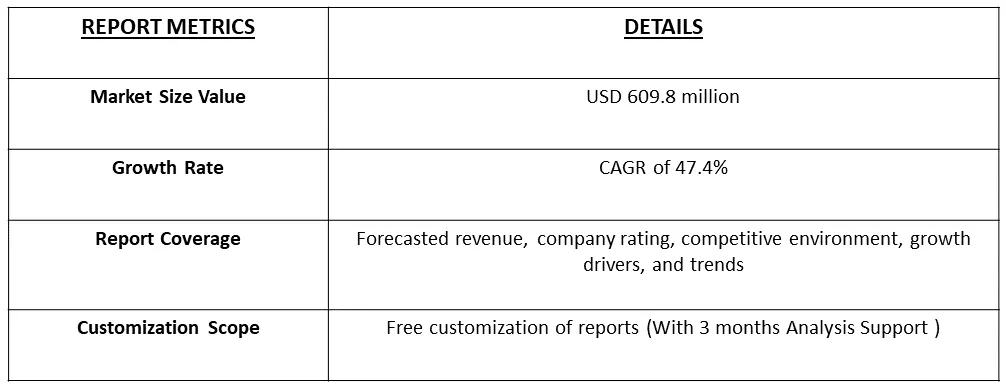The global urgent care apps market size was valued at USD 609.8 million in 2023 and is expected to grow at a compound annual growth rate (CAGR) of 47.4% from 2024 to 2031.

Get Complete Analysis Of The Report - Download Free Sample PDF
Urgent care apps refer to mobile applications designed to provide immediate medical assistance and support for non-emergency health concerns. These apps offer users convenient access to healthcare services, allowing them to seek medical advice, consultation, or information without the need for a physical visit to a healthcare facility. Urgent care apps often connect users with licensed healthcare professionals, including doctors, nurses, or other medical professionals, through virtual consultations, chat, or video calls. These apps may offer features such as symptom assessment, medication reminders, and prescription refills, and can facilitate the scheduling of in-person appointments if necessary. They play a crucial role in improving accessibility to healthcare services, especially for minor health issues or urgent medical inquiries.
The urgent care app market is driven by several key factors, including the benefits provided by these apps such as chronic pain guidance, panic situation pain management functions, reduced hospital readmissions, and immediate appointment booking. There is a growing preference among healthcare facilities to adopt patient-centric care, and urgent care apps play a crucial role in facilitating this shift. Furthermore, the market is witnessing increased demand due to the rising trend of consumers transitioning from traditional communication channels, which are susceptible to interruptions and bottlenecks, to real-time setups that offer various benefits and address significant issues in the healthcare sector. Urgent care apps provide a more efficient and seamless way for users to access healthcare services, contributing to the surge in demand. The prevalence of various health conditions, including trauma, stroke, cardiovascular diseases, Parkinson's disease, and others, is on the rise. The growing adoption of urgent care apps for consultation and treatment at affordable rates is contributing to the market's expansion. As these apps offer quick and accessible healthcare solutions, they become particularly valuable in addressing diverse health concerns and conditions. Thus, the increasing demand for urgent care apps is fueled by their multifaceted benefits, the shift towards patient-centric care, and the rising adoption of real-time healthcare communication solutions to address prevalent issues in the healthcare sector.
Market Segmentation: The Urgent Care Apps Market is Segmented by Type (Pre-hospital Emergency Care and triaging Apps, In-hospital Communication and collaboration Apps, and Post-hospital Apps), Clinical Area (Trauma, Stroke, Cardiac Conditions, Behavioral Health, and Other Clinical Areas), and Geography (North America, Europe, Asia-Pacific, Middle East and Africa, and South America). The report offers the value (in USD million) for the above-mentioned segments.

For Detailed Market Segmentation - Download Free Sample PDF
A prominent trend in the urgent care app market is the integration of telemedicine services. Urgent care apps increasingly offer virtual consultations, enabling users to connect with healthcare professionals remotely for immediate medical advice and assistance. Also, the incorporation of artificial intelligence (AI) and chatbot technology is gaining traction. These features provide users with automated assistance for preliminary symptom assessment, medication reminders, and general health inquiries, enhancing user engagement and efficiency. Moreover, urgent care apps are diversifying their service offerings beyond basic consultations. Many apps now include features such as prescription refills, chronic condition management, mental health support, and specialized care modules, catering to a broader range of healthcare needs. Thus, the urgent care apps market is evolving with trends that emphasize comprehensive and user-centric healthcare solutions, integrating advanced technologies and addressing a broader spectrum of health needs.
Market Drivers:
Growing Healthcare Awareness
Increased awareness about the importance of regular health check-ups and timely medical intervention is driving users to seek healthcare services promptly. Urgent care apps align with this trend by providing a platform for quick health assessments.
The growth of urgent care apps is driven by several key factors. First and foremost, there is a notable increase in the number of individuals experiencing strokes, trauma, and cardiac issues. The World Stroke Organization's Global Stroke Fact Sheet for 2022 reveals an alarming statistic of over 12.2 million new strokes occurring annually worldwide. This surge in critical health conditions is a significant catalyst for the rising demand for urgent care apps, as they provide quick and accessible healthcare solutions. The popularity of mHealth apps is another contributing factor. These mobile health applications are gaining traction, driven by advancements in technologies like Machine Learning, Big Data, and IoT. These innovations enhance the functionalities of urgent care apps, making them more effective in offering timely and personalized healthcare solutions.
Moreover, the growing usage of smartphones and expanding internet penetration globally further support the prevalence of urgent care apps. In regions such as India, where internet users reached 829.30 million by the end of 2021, these apps become more accessible, catering to individuals seeking immediate healthcare assistance. Thus, the growth of urgent care apps is propelled by the increasing incidence of critical health conditions, technological advancements, and the widespread availability of high-speed networks and smartphones, all contributing to the rising demand for quick and convenient healthcare solutions.
Rising Number of Stroke, Trauma, and Cardiac Patients
The surge in the number of individuals affected by stroke, trauma, and cardiac conditions has become a significant driver for the adoption and growth of urgent care apps. Urgent care apps offer individuals experiencing stroke, trauma, or cardiac symptoms the ability to seek immediate medical assistance through virtual consultations. This immediate access can significantly impact the outcome by facilitating quicker response times. By providing users with the means to seek prompt medical attention, urgent care apps empower individuals to take an active role in managing their health. This proactive approach aligns with the growing trend of individuals seeking immediate healthcare solutions.
In 2022, WHO reported that the Global Stroke Factsheet released in 2022 reveals that the lifetime risk of developing a stroke has increased by 50% over the last 17 years and now 1 in 4 people is estimated to have a stroke in their lifetime. Also, World Stroke Organization 2022, reported that there are over 12.2 million new strokes each year. Globally, one in four people over age 25 will have a stroke in their lifetime. The source also reported that 56% of people who have experienced a stroke and are currently living are women. Globally, women account for just over half (56%) of all persons who have experienced a stroke. Thus, the rising number of stroke, trauma, and cardiac patients underscores the critical need for swift and accessible healthcare solutions. Urgent care apps address this need by leveraging technology to provide immediate access to medical professionals, contributing to improved outcomes and enhanced healthcare delivery in emergency situations.
Market Restraints:
Rising Concerns Regarding Data Privacy and Security
Urgent care apps deal with a wealth of personal health data, including medical history, symptoms, and treatment plans. The potential breach of this information raises concerns about patient confidentiality, as individuals worry about unauthorized access to their health records. Urgent care apps may operate across borders, leading to concerns about where patient data is stored and which jurisdiction's data protection laws apply. Navigating these complexities is crucial for maintaining transparency and legal compliance. The healthcare sector is a prime target for cyber threats and data breaches. Urgent care apps, being part of this ecosystem, face the risk of hacking and unauthorized access. Any compromise in the security measures could lead to the exposure of sensitive patient data. Thus, owing to such factors, the market is expected to slow down the growth over the forecast period.
The Urgent Care Apps market experienced significant growth during the COVID-19 pandemic due to the unprecedented challenges faced by traditional healthcare facilities. The surge in hospitalizations, particularly among COVID-19 patients, led to a heightened demand for urgent care apps. Key industry players responded by enhancing their platforms with additional features to address the urgent needs of healthcare systems. For instance, Twiage Solutions Inc. introduced an 'Isolation' module in March 2020 to adapt to the changing demands. The pandemic also accelerated the adoption of urgent care apps, providing a solution to minimize physical contact among healthcare providers. Overall, the COVID-19 crisis played a pivotal role in emphasizing the essential role of urgent care apps in the healthcare landscape.
Segmental Analysis:
Pre-hospital Emergency Care and triaging Apps Segment is Expected to Witness Significant Growth Over the Forecast Period
Pre-hospital emergency care and triaging apps have emerged as critical tools in the realm of emergency medical services, significantly impacting the efficiency and effectiveness of emergency response systems. These applications play a pivotal role in the early stages of patient care, offering a range of functionalities that contribute to improved outcomes. These apps provide immediate access to medical assistance, enabling users to quickly connect with emergency services. Users can initiate a call for help and provide crucial information about the situation, facilitating a prompt and informed response. Many pre-hospital care apps incorporate real-time location-sharing features, allowing emergency services to pinpoint the exact location of the incident. This is crucial for reducing response times and ensuring that help reaches the scene swiftly. Thus, pre-hospital emergency care and triaging apps serve as valuable tools in enhancing the speed, accuracy, and overall quality of emergency medical services. Their integration into healthcare systems and widespread adoption can significantly contribute to improving patient outcomes during critical situations.
Stroke Segment is Expected to Witness Significant Growth Over the Forecast Period
Stroke and urgent care apps play a crucial role in improving the management and outcomes of stroke incidents, providing timely and effective interventions. Urgent care apps enable users to swiftly connect with emergency services in the event of a stroke. Quick access to medical assistance is essential for ensuring timely response and intervention. These apps often incorporate real-time location-sharing features, allowing emergency services to pinpoint the exact location of the stroke incident. This aids in reducing response times and expediting the arrival of medical assistance. Urgent care apps often contribute to community education by providing information about stroke prevention, risk factors, and healthy lifestyle practices. This proactive approach aims to reduce the incidence of strokes through public awareness. Thus, such factors are expected to drive the growth of the studied market over the forecast period.
North America Segment is Expected to Witness Significant Growth Over the Forecast Period
In North America, urgent care apps have gained significant traction, reshaping the landscape of healthcare services and providing a convenient and efficient way for individuals to access immediate medical assistance. North America, particularly the United States and Canada, has witnessed a growing demand for accessible and convenient healthcare solutions. Urgent care apps cater to this demand by offering users the ability to connect with medical professionals, schedule virtual consultations, and receive timely assistance without the need for physical visits to healthcare facilities. Also, the region boasts a high rate of smartphone penetration, with a large percentage of the population owning smartphones. This widespread use of mobile devices creates an ideal environment for the adoption of urgent care apps, allowing users to seek medical advice, schedule appointments, and receive healthcare information conveniently through their smartphones. Urgent care apps often extend their services to include support for chronic disease management. Individuals with chronic conditions can benefit from ongoing virtual consultations, remote monitoring, and access to healthcare resources, contributing to better long-term health outcomes. Thus, the widespread adoption of urgent care apps in North America reflects the region's commitment to leveraging technology to enhance healthcare accessibility and address the evolving needs of the population. The convenience, cost-effectiveness, and technological sophistication of these apps make them integral components of the modern healthcare landscape in North America.

Get Complete Analysis Of The Report - Download Free Sample PDF
The landscape of the urgent care apps market exhibits a somewhat consolidated nature, characterized by the limited number of companies operating on a global scale. The competitive scenario involves an in-depth analysis of a select few global entities that wield substantial market shares. This implies that a small group of companies plays a dominant role in shaping the dynamics of the urgent care apps market. Some of the key market players are:
Recent Development:
1) In November 2021, ALLM Inc. collaborated with SVIN Mission Thrombectomy 2020+ (MT2020+) through the EnJoin program, aiming to enhance stroke care both in the United States and globally.
2) In March 2021, SHOP APOTHEKE EUROPE completed the acquisition of smartpatient gmbh, a move that bolstered the company's technological prowess and digital health capabilities.
Q1. What was the Urgent Care Apps Market size in 2023?
As per Data Library Research the global urgent care apps market size was valued at USD 609.8 million in 2023.
Q2. At what CAGR is the Urgent Care Apps market projected to grow within the forecast period?
Urgent Care Apps Market is expected to grow at a compound annual growth rate (CAGR) of 47.4% over the forecast period.
Q3. What are the factors driving the Urgent Care Apps market?
Key factors that are driving the growth include the Growing Healthcare Awareness and Rising Number of Stroke, Trauma, and Cardiac Patients.
Q4. Which factor is Limiting the growth of Urgent Care Apps market?
Rising Concerns Regarding Data Privacy and Security factor is Limiting the growth of Urgent Care Apps market.
Data Library Research are conducted by industry experts who offer insight on industry structure, market segmentations technology assessment and competitive landscape (CL), and penetration, as well as on emerging trends. Their analysis is based on primary interviews (~ 80%) and secondary research (~ 20%) as well as years of professional expertise in their respective industries. Adding to this, by analysing historical trends and current market positions, our analysts predict where the market will be headed for the next five years. Furthermore, the varying trends of segment & categories geographically presented are also studied and the estimated based on the primary & secondary research.
In this particular report from the supply side Data Library Research has conducted primary surveys (interviews) with the key level executives (VP, CEO’s, Marketing Director, Business Development Manager and SOFT) of the companies that active & prominent as well as the midsized organization
FIGURE 1: DLR RESEARH PROCESS

Extensive primary research was conducted to gain a deeper insight of the market and industry performance. The analysis is based on both primary and secondary research as well as years of professional expertise in the respective industries.
In addition to analysing current and historical trends, our analysts predict where the market is headed over the next five years.
It varies by segment for these categories geographically presented in the list of market tables. Speaking about this particular report we have conducted primary surveys (interviews) with the key level executives (VP, CEO’s, Marketing Director, Business Development Manager and many more) of the major players active in the market.
Secondary ResearchSecondary research was mainly used to collect and identify information useful for the extensive, technical, market-oriented, and Friend’s study of the Global Extra Neutral Alcohol. It was also used to obtain key information about major players, market classification and segmentation according to the industry trends, geographical markets, and developments related to the market and technology perspectives. For this study, analysts have gathered information from various credible sources, such as annual reports, sec filings, journals, white papers, SOFT presentations, and company web sites.
Market Size EstimationBoth, top-down and bottom-up approaches were used to estimate and validate the size of the Global market and to estimate the size of various other dependent submarkets in the overall Extra Neutral Alcohol. The key players in the market were identified through secondary research and their market contributions in the respective geographies were determined through primary and secondary research.
Forecast Model
